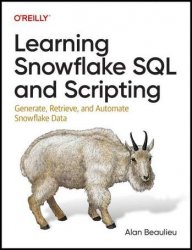 Название: Learning Snowflake SQL and Scripting: Generate, Retrieve, and Automate Snowflake Data Название: Learning Snowflake SQL and Scripting: Generate, Retrieve, and Automate Snowflake Data
Автор: Alan Beaulieu
Издательство: O’Reilly Media, Inc.
Год: 2024
Страниц: 762
Язык: английский
Формат: pdf, epub (true)
Размер: 11.2 MB
To help you on the path to becoming a Snowflake pro, this concise yet comprehensive guide reviews fundamentals and best practices for Snowflake's SQL and Scripting languages. Developers and data professionals will learn how to generate, modify, and query data in the Snowflake relational database management system as well as how to apply analytic functions for reporting.
Author Alan Beaulieu also shows you how to create scripts, stored functions, and stored procedures to return data sets using Snowflake Scripting. This book is ideal whether you're new to databases and need to run queries or reports against a Snowflake database, or transitioning from databases such as Oracle, SQL Server, or MySQL to cloud-based platforms.
Perhaps you are brand new to databases and will need to run queries or reports against a Snowflake database. Or perhaps, like myself, you have been working with databases such as Oracle, SQL Server, or MySQL for years, and your company has begun transitioning to cloud-based platforms. Whatever the case, this book strives to empower you with a detailed understanding of Snowflake’s SQL implementation so that you can be as effective as possible.
To help put things in context, I’ll start with a brief history of databases, starting with the introduction of relational databases in the 1980s and leading up to the availability of cloud-based database platforms such as Snowflake. If you’re ready to jump right into learning SQL, feel free to move on to Chapter 1, but you should read “Setting Up a Sample Database” if you want to create your own database with which to experiment.
What Is SQL Scripting? If you have programmed with a procedural language such as Java, C#, or Go, you are familiar with such programming constructs as looping, if-then-else, and exception handling. SQL, being a nonprocedural language, has none of these constructs. To bridge this gap, most database platforms provide both a nonprocedural SQL implementation along with a procedural language that includes both the SQL data statements such as select and insert along with all of the usual procedural programming constructs. Oracle, for example, provides the PL/SQL procedural language, while Microsoft provides the Transact-SQL language. Snowflake provides the Snowflake Scripting language, which allows you to declare variables, incorporate looping and if-then-else statements, and detect and handle exceptions. Snowflake Scripting language will be covered in Chapters 15, 16, and 17 of this book.
With this book, you will:
• Generate and modify Snowflake data using Insert, Update, Delete
• Query data in Snowflake using Select, including joining multiple tables, using subqueries, and grouping
• Apply analytic functions for performing subtotals, grand totals, row comparisons, and other reporting functionality
• Build scripts combining SQL statements with looping, if-then-else, and exception handling
• Learn how to build stored procedures and functions
• Use stored procedures to return data sets
Скачать Learning Snowflake SQL and Scripting: Generate, Retrieve, and Automate Snowflake Data
|